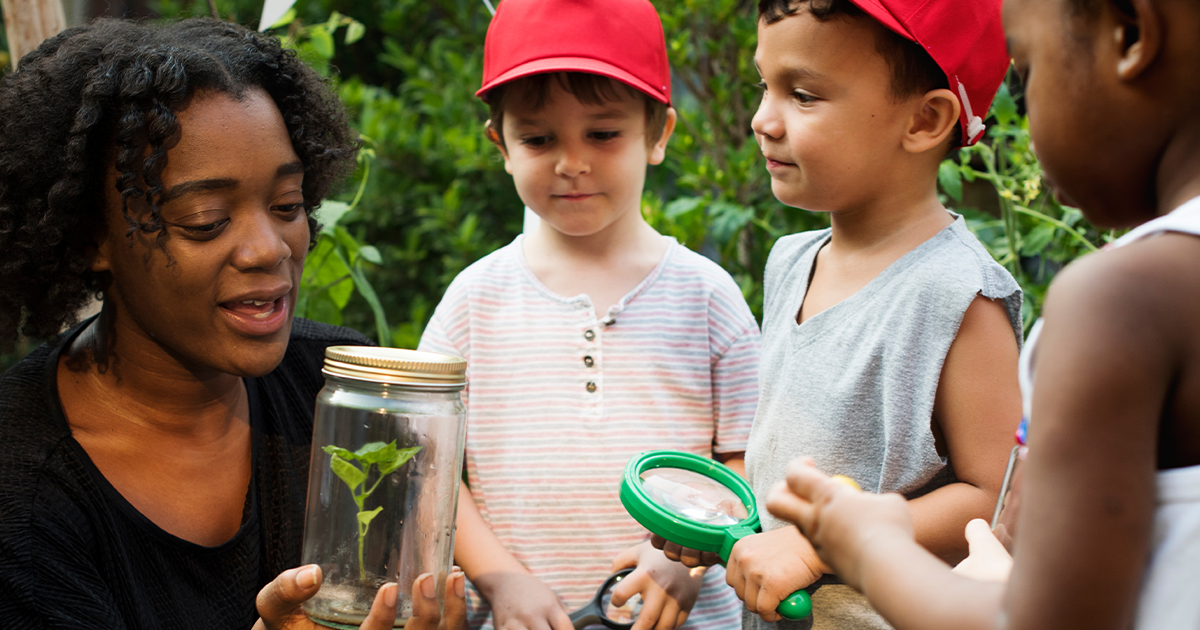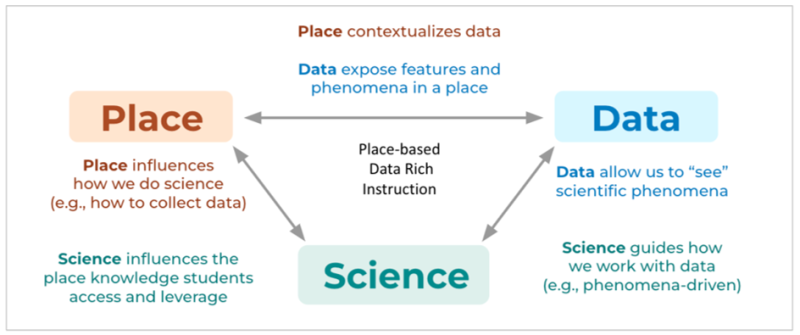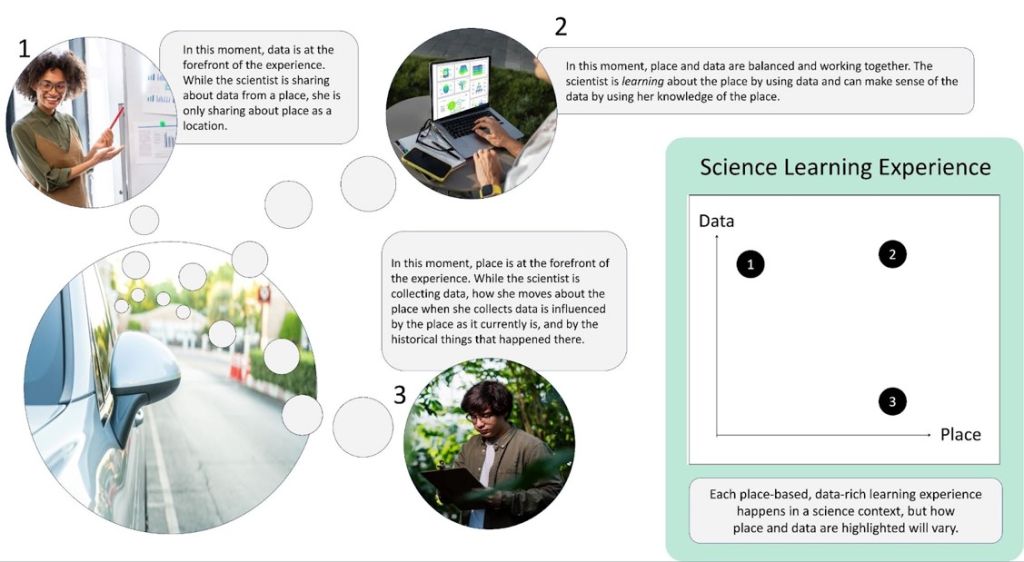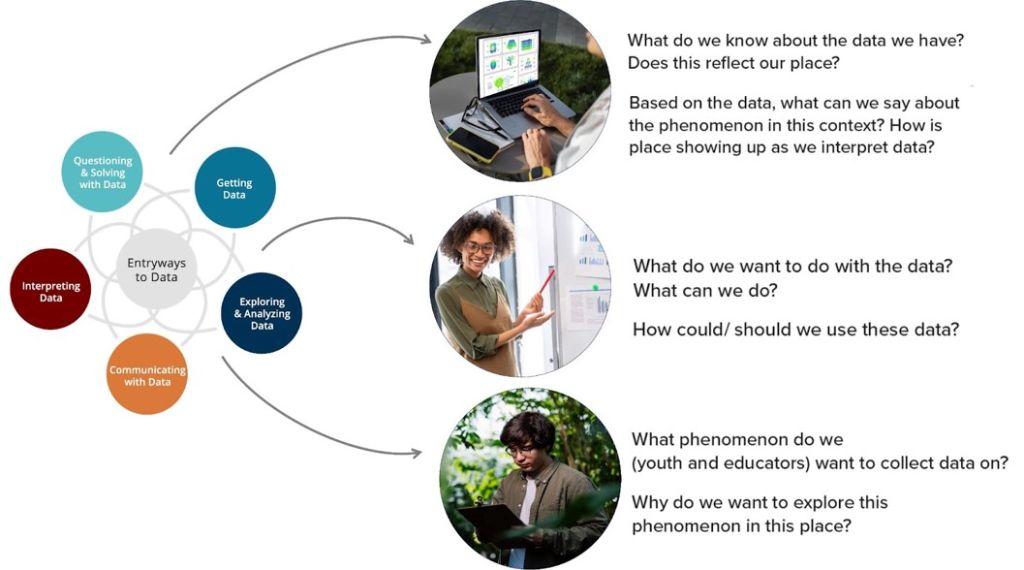Discoveries Nearby: Integrating Place-Based, Data-Rich Instruction in Science Education
Posted on

Written by Sara Salisbury, Leticia Perez, and Karen Lionberger. This article first appeared on NextGenScience’s On the Same Wavelength blog and is adapted and posted here with permission.
“I was driving in the car this morning when a construction project slowed down the flow of traffic. Sitting and waiting, I looked out my window and saw what looked like a bunch of weeds…but they were swarming with butterflies and birds! It just looked like a bunch of unmowed mess. I had so many questions…like…why were these critters there, even though I didn’t see any flowers or food? Had these critters always been here and I just never noticed?”
Exploring data from local places can help students develop a sense of curiosity, connect to their communities, and learn science. “Places” are not just physical locations. A place is imbued with cultures, beliefs, identities, and histories. All of these parts of a place influence how one experiences it, and the data that can come from it.
With that in mind, let’s ask questions with a place and data frame of mind:
- How does the number of butterflies in this area compare to areas with fewer cars?
- What animals or people in our neighborhood use these plants as resources?
- How has the number of plants in this place changed over time?
When students have the opportunity to ask and explore these types of questions, they are encouraged to draw on their knowledge of the local community as a resource for engaging in science: doing science like scientists do. As noted in the Next Generation Science Standards (NGSS), this is beneficial because: “Engaging in practices that mirror those of professional scientists and engineers helps students understand the nature of science.”
Developing science learning that gives a more “central role to students’ lived experiences and identities” positively impacts learners’ persistence in science, knowledge of, and connection to, community and science learning. These types of experiences are foundational for developing a sustained interest in science and fostering a scientifically literate society.
“Students are naturally inquisitive and are eager to learn how to collect data ‘like a scientist’… especially when it stems from a problem that they identified.”
– PLACES Pilot study teacher
Place-Based, Data-Rich Instruction
Depending on the questions you ask, data reflecting a place can come from many different sources like maps, historical accounts, photographs, measurements, and experiments. Generating and/or using qualitative and quantitative data from a place opens up opportunities for science learning that integrates the everyday knowledge and expertise that students have about their worlds.
Our PLACES project, which stands for Broadening Data Fluency Through the Integration of NASA Assets and Place-Based Learning to Advance Connections, Education, and Stewardship, has focused on helping teachers across the United States lean into questions such as the ones we present above. Through professional learning, we help teachers cultivate Place-based, Data-rich Instruction, which uses place, data, and science together to create contextually rich, rigorous, and meaningful learning experiences for their students. PLACES is a NASA Science Activation Project that focuses on designing professional learning to support teachers in bringing Place-based, Data-rich Instruction into their Earth science classes utilizing NASA-developed lessons, datasets, and data visualization tools.

How will I know if I’m creating place-based, data-rich experiences?
Our PLACES framework below showcases the possibilities for Place-based, Data-rich Instruction. There are three key features in the framework: place, data, and science. Each arrow in the framework describes how the three key features interact when one engages in place-based and data-rich work when doing science.

In place-based, data-rich learning experiences, we generally aim to amplify these interactions (however, we do not expect that a learning experience can amplify all of the interactions at each moment).
Below we share some examples of what place-based, data-rich experiences could look like.

In a more data-forward experience (#1 in the Examples of the PLACES Framework In Action image above), a learner might engage in communicating information by co-developing norms for science communication in their classroom community to represent and share their findings, ideas, and explanations using data from a specific place. Here, science practices are influencing how one represents and communicates about data that was derived from a place.
In a learning experience where place and data are balanced (#2 in the Examples of the PLACES Framework In Action image above), learners interested in plants could respond to questions (e.g., What animals or people in our neighborhood use this plant as a resource?) by analyzing and interpreting data about plant and animal species diversity to better understand local food webs. In this way, they are doing science by using data to learn more about place.
In a more place-forward experience (#3 in the Examples of the PLACES Framework In Action image above), learners might use their family’s knowledge of seasonal plant growth or animal behavior in their area to plan and carry out an investigation to identify the best time of the year to do field work. Here, knowledge of a place is influencing how they do science and gather data.
Doing science and working with data is a human process that is impacted by lived experiences, background knowledge, and culture of the people doing the science. Thus, scientists (and science learners) use many different pathways when doing science and their sequences will naturally vary. To open up inquiry opportunities and showcase the very human ways one can work with data and place when doing science, we created a list of Place Conscious Questions that bring to light the relationships between place, data, and science.
These questions serve to support the design of place-based, data-rich lessons and projects (e.g., finding data sets, generating tasks to go alongside data, and prompting students for feedback), and reference the Entryways to Data, which describe different opportunities for incorporating data into learning.

Next Steps
Thus far in the PLACES project, we’ve had some incredible partner teachers take on the exciting task of implementing Place-based, Data-rich Instruction in their own classes. Teachers came together to share what they did, identify both pain points and things that brought them joy, and give and receive feedback. From our PLACES teachers, we’ve learned a great deal about what works, and areas for improvement.
Our next steps in the project will focus on integrating the teachers’ materials, feedback, and learning outcomes as we improve our professional learning. Stay tuned for another blog article later this year showcasing our findings!
WestEd’s Making Sense of SCIENCE team specializes in research-based, effective professional learning for STEM educators. We have a wide range of opportunities, such as: developing data fluency teaching and learning practices including place-based approaches, content-specific courses (e.g., Energy, Dynamic Earth, Genes & Traits), a focus on implementing science practices and cross-cutting concepts, and opportunities specifically designed to support science teacher leaders.
Is your school or district interested in learning more about WestEd’s professional learning opportunities? For more information, please reach out to Karen Lionberger at [email protected]
Sara Salisbury is a Research Associate and a Professional Learning Specialist in the Science and Engineering Department at WestEd. As a former ecologist and informal educator, her interests lie at the intersection of place-based education, data science, and equitable education. Her goals are to honor and amplify how science looks different in different places and to different communities.
Leticia Perez is a Data Science and Professional Learning Specialist in the Science and Engineering Department at WestEd. As a former high school science teacher, her interests center around respectful and impactful science and data science professional learning. Her more recent work includes designing professional learning for K–12 educators that incorporates data science and computational thinking into classrooms.
Karen Lionberger is the Associate Director for Making Sense of SCIENCE in the Science and Engineering Department at WestEd. Her work focuses on developing equity-driven curriculum, professional learning, and assessments that promote deeper teacher and student engagement and self-confidence in STEM. The dedication to this work is rooted in her experiences as a high school science teacher.
